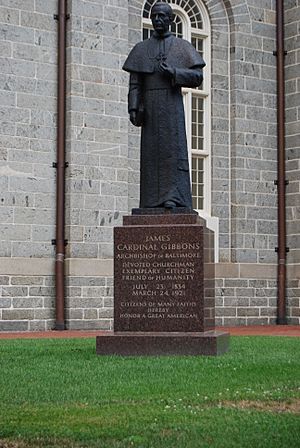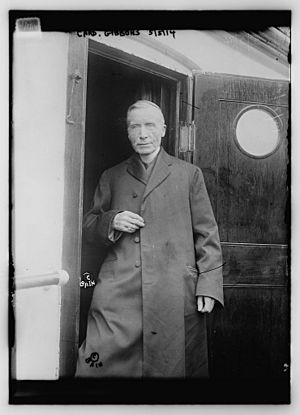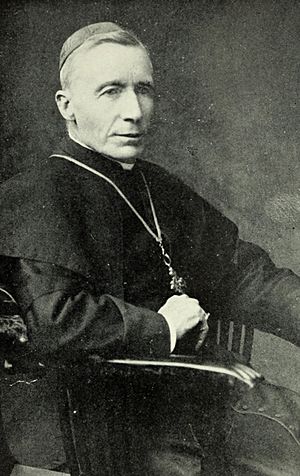James Gibbons facts for kids
Quick facts for kids His Eminence James Gibbons |
|
|---|---|
| Cardinal Archbishop of Baltimore |
|
 |
|
| See | Archdiocese of Baltimore |
| Appointed | May 29, 1877 (coadjutor) |
| Enthroned | October 3, 1877 |
| Reign ended | March 24, 1921 |
| Predecessor | James Roosevelt Bayley |
| Successor | Michael Joseph Curley |
| Other posts | Cardinal-Priest of Santa Maria in Trastevere |
| Orders | |
| Ordination | June 30, 1861 |
| Consecration | August 15, 1868 by Martin John Spalding |
| Created Cardinal | June 7, 1886 |
| Rank | Cardinal- Priest |
| Personal details | |
| Born | July 23, 1834 Baltimore, Maryland |
| Died | March 24, 1921 (aged 86) Baltimore, Maryland |
| Previous post | Bishop of Richmond (1872–77) |
| Motto | Emitte spiritum tuum (Send forth your spirit) |
| Signature | |
James Cardinal Gibbons (July 23, 1834 – March 24, 1921) was a senior-ranking American prelate of the Catholic Church who served as apostolic vicar of the Apostolic Vicariate of North Carolina from 1868 to 1872, bishop of the Diocese of Richmond in Virginia from 1872 to 1877, and as ninth archbishop of the Archdiocese of Baltimore in Maryland from 1877 until his death. He was elevated to the rank of cardinal in 1886.
Gibbons was consecrated a bishop on August 16, 1868, at the Baltimore Cathedral. The principal consecrator was Archbishop Martin J. Spalding. He was 34 years of age, serving as the first apostolic vicar of North Carolina. He attended the First Vatican Council in Rome where he voted in favor of defining the dogma of papal infallibility.
In 1872, Gibbons was named bishop of Richmond by Pope Pius IX. In 1877, Gibbons was appointed archbishop of Baltimore, the premier episcopal see in the United States. During his 44 years as Baltimore's archbishop, Gibbons became one of the most recognizable Catholic figures in the country. He defended the rights of organized labor and helped convince Pope Leo XIII to give his consent to labor unions. In 1886, Gibbons was appointed to the College of Cardinals, becoming the second cardinal in American history, after Cardinal John McCloskey, archbishop of New York.
Contents
Early life and education
Gibbons was born in Baltimore, Maryland, the fourth of six children, to Thomas and Bridget (née Walsh) Gibbons. His parents were from Tourmackeady, County Mayo, in Ireland. The family left Ireland to settle in Canada, and later moved to the United States.
After contracting tuberculosis in 1839, Thomas moved the family back to Ireland, where he believed the climate would help him recover. Thomas operated a grocery store in Ballinrobe, and James Gibborns received his early education there. Thomas died in Ireland in 1847. In 1853, Bridget moved the family back to the United States, where they settled in New Orleans.
Gibbons decided to enter the priesthood after attending a sermon given by Paulis Fathers co-founder, Reverend Clarence A. Walworth. In 1855, Gibbons entered St. Charles College in Ellicott City, Maryland. After graduating from St. Charles in 1857, he went to St. Mary's Seminary in Baltimore. He suffered a severe attack of malaria while at St. Mary's, leaving him so debilitated that the staff doubted his ability to handle ordination. Slight of build and a little under than average height, Gibbons suffered throughout his life from gastric problems and consequent periods of anxiety and clinical depression.
Priesthood
On June 30, 1861, Gibbons was ordained to the priesthood for the Archdiocese of Baltimore by Archbishop Francis Kenrick at the Baltimore Cathedral. He then served as a curate at St. Patrick's Parish in Fells Point in Baltimore for six weeks before becoming the first pastor of St. Brigid's Parish in the Canton section of the city. In addition to his duties at St. Brigid's, he assumed charge of St. Lawrence Parish (now called Our Lady of Good Counsel Parish) in Locust Point, Baltimore. Gibbons served as a chaplain for Confederate Army prisoners of war at Fort McHenry in Baltimore during the American Civil War.
In 1865, Gibbons was appointed private secretary to Archbishop Martin Spalding. Gibbons helped prepare for the Second Plenary Council of Baltimore in October 1866. At Spalding's prompting, the Council fathers recommended the Vatican created an apostolic vicariate for North Carolina and appoint Gibbons head to it.
Episcopal career
Apostolic Vicar of North Carolina
On March 3, 1868, Gibbons was appointed as the first apostolic vicar of North Carolina and Titular Bishop of Adramyttium by Pope Pius IX. He received his episcopal consecration on August 15, 1868, from Archbishop Spalding, with Bishops Patrick Lynch and Michael Domenec serving as co-consecrators. The consecrated was celebrated at the Baltimore Cathedral. At age 34, he was one of the youngest Catholic bishops in the world and was known as "the boy bishop."
Gibbons' vicariate, the entire state of North Carolina, contained fewer than 700 Catholics. In his first four weeks in North Carolina, he traveled almost a thousand miles, visiting towns and mission stations and administering the sacraments. He also befriended many Protestants, who greatly outnumbered Catholics in the state, and preached at their churches. Gibbons made a number of converts. Finding the existing apologetical works to be inadequate for their needs, he determined to write his own; Faith of Our Fathers would prove the most popular apologetical work written by an American Catholic.
Gibbons became a popular American religious figure, gathering crowds for his sermons on diverse topics that could apply to Christianity as a whole. He knew every president from Andrew Johnson to Warren G. Harding and served as an adviser to several of them.
In 1869 and 1870 Gibbons attended the First Vatican Council in Rome. Aged 35 years and 4 months when the Council opened, he was the youngest American bishop present by a mere six days (the second youngest was Jeremiah Francis Shanahan, Bishop of Harrisburg) and the second youngest in all (Basilio Nasser, Melkite Bishop of Baalbek, Lebanon, was more than five years his junior, aged just 30 years and 3 months at opening). Gibbons voted in favor of the doctrine of papal infallibility. He assumed the additional duties of apostolic administrator for the Diocese of Richmond, Virginia, in January 1872.
Bishop of Richmond
Gibbons was named by Pius IX as the fourth bishop of the Diocese of Richmond on July 30, 1872. He was installed as bishop on October 20, 1872.
Coadjutor Archbishop and Archbishop of Baltimore
On May 29, 1877, Piux IX named Gibbons as coadjutor archbishop of the Archdiocese of Baltimore. He succeeded as archbishop on October 3, 1877, after the death of Archbishop James Bayley. For the first twenty years of his administration, Gibbons had no auxiliary bishop to assist him. He therefore travelled extensively throughout the archdiocese, coming to know the priests and parishioners very well.
Cardinal Priest
On June 7, 1886, Pope Leo XIII created Gibbons as a cardinal priest and on March 17, 1887, assigned him the titular church of Santa Maria in Trastevere. He was the second American cardinal after John McCloskey. Gibbons advocated the creation of the Catholic University of America in Washington, D.C., and when it was established in 1887, served as its first Chancellor.
On January 22, 1899, Leo XIII sent Gibbons an encyclical, known by its first words in Latin Testem benevolentiae nostrae ("Concerning New Opinions, Virtue, Nature and Grace, with Regard to Americanism"), condemning what was termed "Americanism". This encyclical was prompted by the preface of the French translation of the biography Life of Isaac Hecker, the founder of the Paulist Fathers in the United States. The Vatican had decided that the preface contained controversial opinions about individualism and liberalism, which the translator, Abbey Félix Klein, had attributed to Hecker. Gibbons and others in the American church hierarchy assured Leo that these were Klein's opinions, not Hecker's, and that Hecker never promoted any deviation from, or minimization of, Catholic doctrines.
In 1903, Gibbons became the first American cardinal to articipate in a papal conclave. He would have participated in the 1914 conclave but he arrived late.
During World War I, Gibbons was instrumental in the establishment of the National Catholic War Council. He allowed the newly ordained William A Hemmick to serve American troops in France during the war. Hemmick became known as the patriot priest of Picardy. At the end of the war, Gibbons supported American participation in the new League of Nations. He was initially opposed to the women's suffrage movement in the United States. However, when the nineteenth amendment to the US Constitution passed in 1920, allowing women to vote, Gibbons urged women to exercise that right, describing it "...not only as a right but as a strict social duty."
James Gibbons died on March 24, 1921, in Baltimore at age 86.
Labor advocate
Gibbons advocated for the protection of working people, an issue of particular concern because he believed many Catholics were being exploited by the industrial expansion of America's urban East Coast at the turn of the century. He was once quoted as saying, "It is the right of laboring classes to protect themselves, and the duty of the whole people to find a remedy against avarice, oppression, and corruption." Gibbons played a key role in the granting of papal permission for Catholics to join labor unions.
Gibbons successfully defended the Knights of Labor, which had a significant Catholic membership, from papal censure, thereby winning a reputation as labor's friend. However, he deplored the concept of class consciousness as outlined in Marxism and condemned industrial violence during labor disputes.
Works
Part of Gibbons' popularity derived from the works he authored. Among his widely read works were: Our Christian Heritage (1889), The Ambassador of Christ (1896), Discourses and Sermons (1908), and A Retrospect of Fifty Years (1916). He contributed a number of essays to much-read journals such as the North American Review and Putnams' Monthly. He was also a contributor to the Catholic Encyclopedia. His style was simple but compelling. Protestant Americans looked often to Gibbons for an explanation of the Catholic position on contentious issues.
In 1876, Gibbons published his most famous and highly regarded (even among Protestants) book, The Faith of Our Fathers: A Plain Exposition and Vindication of the Church Founded by Our Lord Jesus Christ [1].

See also
 In Spanish: James Gibbons para niños
In Spanish: James Gibbons para niños
- Catholic Church in the United States
- Historical list of the Catholic bishops of the United States
- James Cardinal Gibbons Medal
- List of Catholic bishops of the United States
- Lists of patriarchs, archbishops, and bishops
- Papal infallibility




